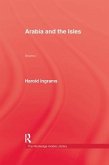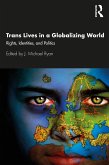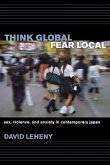- Broschiertes Buch
- Merkliste
- Auf die Merkliste
- Bewerten Bewerten
- Teilen
- Produkt teilen
- Produkterinnerung
- Produkterinnerung
This book explores the historical and contemporary processes that have made and remade Mongolia as it is today: the construction of ethnic and national cultures, the transformations of political economy and a 'nomadic' pastoralism, and the revitalization of a religious and cosmological heritage that has led to new forms of post-socialist politics. Widely published as an expert in the field, David Sneath offers a fresh perspective into a region often seen as mysterious to the West.
Andere Kunden interessierten sich auch für
![Arabia and The Isles Arabia and The Isles]() Harold IngramsArabia and The Isles64,99 €
Harold IngramsArabia and The Isles64,99 €![Trans Lives in a Globalizing World Trans Lives in a Globalizing World]() Trans Lives in a Globalizing World52,99 €
Trans Lives in a Globalizing World52,99 €![Jenseits von Natur und Kultur Jenseits von Natur und Kultur]() Philippe DescolaJenseits von Natur und Kultur30,00 €
Philippe DescolaJenseits von Natur und Kultur30,00 €![Think Global, Fear Local Think Global, Fear Local]() David LehenyThink Global, Fear Local21,99 €
David LehenyThink Global, Fear Local21,99 €![Fetischismus Fetischismus]() Fetischismus22,00 €
Fetischismus22,00 €![Japan's Cultural Code Words Japan's Cultural Code Words]() Boye Lafayette De MenteJapan's Cultural Code Words13,99 €
Boye Lafayette De MenteJapan's Cultural Code Words13,99 €![Letters from Thailand Letters from Thailand]() BotanLetters from Thailand23,99 €
BotanLetters from Thailand23,99 €-
-
-
This book explores the historical and contemporary processes that have made and remade Mongolia as it is today: the construction of ethnic and national cultures, the transformations of political economy and a 'nomadic' pastoralism, and the revitalization of a religious and cosmological heritage that has led to new forms of post-socialist politics. Widely published as an expert in the field, David Sneath offers a fresh perspective into a region often seen as mysterious to the West.
Produktdetails
- Produktdetails
- Verlag: Taylor & Francis Ltd
- Seitenzahl: 226
- Erscheinungstermin: 1. Dezember 2025
- Englisch
- Abmessung: 234mm x 156mm
- ISBN-13: 9781041183037
- ISBN-10: 1041183038
- Artikelnr.: 75620895
- Herstellerkennzeichnung
- Libri GmbH
- Europaallee 1
- 36244 Bad Hersfeld
- gpsr@libri.de
- Verlag: Taylor & Francis Ltd
- Seitenzahl: 226
- Erscheinungstermin: 1. Dezember 2025
- Englisch
- Abmessung: 234mm x 156mm
- ISBN-13: 9781041183037
- ISBN-10: 1041183038
- Artikelnr.: 75620895
- Herstellerkennzeichnung
- Libri GmbH
- Europaallee 1
- 36244 Bad Hersfeld
- gpsr@libri.de
David Sneath is the Director of the Mongolia and Inner Asia Studies Unit and Reader at the Department of Social Anthropology, University of Cambridge. He has over 50 publications including three monographs and three multi-volume edited works. Professor Caroline Humphrey is an anthropologist who has worked across Asia and countries of the former Soviet Union. She is currently based at the Mongolia and Inner Asia Studies Unit at Cambridge, which she co-founded, and she is a Director of Research at the Department of Social Anthropology. She has been a Fellow of King's since 1978. Franck Billé is a cultural anthropologist based at the University of California, Berkeley, where he is program director for the Tang Center for Silk Road Studies. He is the author of Sinophobia (Hawaii, 2015), coauthor of On the Edge (Harvard, 2021), editor of Voluminous States (Duke, 2020), and coeditor of Yellow Perils (Hawaii, 2019) and Frontier Encounters (Open Book, 2012). He is currently finalizing his latest book, Somatic States: On Cartography, Geobodies, Bodily Integrity (Duke University Press). More information about his current research is available on his website: www.franckbille.com.
Chapter 1. Introduction Part I: The Making and Remaking of Mongolia Part
II: Masters of the Steppe: Peoples of Mongolia (First published in
Fitzhugh, Rossabi & Honeychurch (eds.) 2009. Genghis Khan and the Mongol
Empire, Washington: Smithsonian Arctic Studies Center). Part III: The
Ending of the Old Order Part IV: Making Mongolia Modern Chapter 2. Mapping
and the Headless State: Rethinking national populist concepts of Mongolia
(first published in Sabloff, P. (ed.) 2011. Mapping Mongolia: Situating
Mongolia in the World from Geologic Time to the Present, Philadelphia:
University of Pennsylvania Press). Chapter 3. The Rural and the Urban in
Pastoral Mongolia (first published in in Bruun, O. and Narangoa, L., (eds.)
2005. Mongolians from Country to City: Floating Boundaries, Pastoralism and
City Life in the Mongol Lands, Copenhagen: NIAS Press). Chapter 4.
Proprietary Regimes and Sociotechnical Systems: Rights over Land in
Mongolia's 'age of the market' (first published in Verdery, K., and
Humphrey C., (eds.) 2004. Property in Question: Value Transformation in the
Global Economy, Oxford: Berg). Chapter 5 Political Mobilization and the
Construction of Collective Identity in Mongolia (first published in Central
Asia Survey 29(3), 2010). Chapter 6 The Age of the Market and the Regime of
Debt: The role of credit in the transformation of pastoral Mongolia (first
published in Social Anthropology/ Anthropologie Sociale 20(4), 2012).
Chapter 7 Reading the Signs by Lenin's Light: Development, divination and
metonymic fields in Mongolia (first published in Ethnos 74(1), 2009).
Chapter 8 Ritual Idioms and Spatial Orders: Comparing the rites for
Mongolian and Tibetan 'local deities' (first published in in Bulag, U., and
Diemberger, H., (eds.) 2007. The Mongol-Tibet Interface: Opening new
research terrains in Inner Asia, Leiden: Brill). Chapter 9 Nationalizing
Civilizational Resources: Sacred mountains and cosmopolitical ritual in
Mongolia (first published in Asian Ethnicity 15(4), 2014). Chapter 10
Mongolian Capitalism.
II: Masters of the Steppe: Peoples of Mongolia (First published in
Fitzhugh, Rossabi & Honeychurch (eds.) 2009. Genghis Khan and the Mongol
Empire, Washington: Smithsonian Arctic Studies Center). Part III: The
Ending of the Old Order Part IV: Making Mongolia Modern Chapter 2. Mapping
and the Headless State: Rethinking national populist concepts of Mongolia
(first published in Sabloff, P. (ed.) 2011. Mapping Mongolia: Situating
Mongolia in the World from Geologic Time to the Present, Philadelphia:
University of Pennsylvania Press). Chapter 3. The Rural and the Urban in
Pastoral Mongolia (first published in in Bruun, O. and Narangoa, L., (eds.)
2005. Mongolians from Country to City: Floating Boundaries, Pastoralism and
City Life in the Mongol Lands, Copenhagen: NIAS Press). Chapter 4.
Proprietary Regimes and Sociotechnical Systems: Rights over Land in
Mongolia's 'age of the market' (first published in Verdery, K., and
Humphrey C., (eds.) 2004. Property in Question: Value Transformation in the
Global Economy, Oxford: Berg). Chapter 5 Political Mobilization and the
Construction of Collective Identity in Mongolia (first published in Central
Asia Survey 29(3), 2010). Chapter 6 The Age of the Market and the Regime of
Debt: The role of credit in the transformation of pastoral Mongolia (first
published in Social Anthropology/ Anthropologie Sociale 20(4), 2012).
Chapter 7 Reading the Signs by Lenin's Light: Development, divination and
metonymic fields in Mongolia (first published in Ethnos 74(1), 2009).
Chapter 8 Ritual Idioms and Spatial Orders: Comparing the rites for
Mongolian and Tibetan 'local deities' (first published in in Bulag, U., and
Diemberger, H., (eds.) 2007. The Mongol-Tibet Interface: Opening new
research terrains in Inner Asia, Leiden: Brill). Chapter 9 Nationalizing
Civilizational Resources: Sacred mountains and cosmopolitical ritual in
Mongolia (first published in Asian Ethnicity 15(4), 2014). Chapter 10
Mongolian Capitalism.
Chapter 1. Introduction Part I: The Making and Remaking of Mongolia Part
II: Masters of the Steppe: Peoples of Mongolia (First published in
Fitzhugh, Rossabi & Honeychurch (eds.) 2009. Genghis Khan and the Mongol
Empire, Washington: Smithsonian Arctic Studies Center). Part III: The
Ending of the Old Order Part IV: Making Mongolia Modern Chapter 2. Mapping
and the Headless State: Rethinking national populist concepts of Mongolia
(first published in Sabloff, P. (ed.) 2011. Mapping Mongolia: Situating
Mongolia in the World from Geologic Time to the Present, Philadelphia:
University of Pennsylvania Press). Chapter 3. The Rural and the Urban in
Pastoral Mongolia (first published in in Bruun, O. and Narangoa, L., (eds.)
2005. Mongolians from Country to City: Floating Boundaries, Pastoralism and
City Life in the Mongol Lands, Copenhagen: NIAS Press). Chapter 4.
Proprietary Regimes and Sociotechnical Systems: Rights over Land in
Mongolia's 'age of the market' (first published in Verdery, K., and
Humphrey C., (eds.) 2004. Property in Question: Value Transformation in the
Global Economy, Oxford: Berg). Chapter 5 Political Mobilization and the
Construction of Collective Identity in Mongolia (first published in Central
Asia Survey 29(3), 2010). Chapter 6 The Age of the Market and the Regime of
Debt: The role of credit in the transformation of pastoral Mongolia (first
published in Social Anthropology/ Anthropologie Sociale 20(4), 2012).
Chapter 7 Reading the Signs by Lenin's Light: Development, divination and
metonymic fields in Mongolia (first published in Ethnos 74(1), 2009).
Chapter 8 Ritual Idioms and Spatial Orders: Comparing the rites for
Mongolian and Tibetan 'local deities' (first published in in Bulag, U., and
Diemberger, H., (eds.) 2007. The Mongol-Tibet Interface: Opening new
research terrains in Inner Asia, Leiden: Brill). Chapter 9 Nationalizing
Civilizational Resources: Sacred mountains and cosmopolitical ritual in
Mongolia (first published in Asian Ethnicity 15(4), 2014). Chapter 10
Mongolian Capitalism.
II: Masters of the Steppe: Peoples of Mongolia (First published in
Fitzhugh, Rossabi & Honeychurch (eds.) 2009. Genghis Khan and the Mongol
Empire, Washington: Smithsonian Arctic Studies Center). Part III: The
Ending of the Old Order Part IV: Making Mongolia Modern Chapter 2. Mapping
and the Headless State: Rethinking national populist concepts of Mongolia
(first published in Sabloff, P. (ed.) 2011. Mapping Mongolia: Situating
Mongolia in the World from Geologic Time to the Present, Philadelphia:
University of Pennsylvania Press). Chapter 3. The Rural and the Urban in
Pastoral Mongolia (first published in in Bruun, O. and Narangoa, L., (eds.)
2005. Mongolians from Country to City: Floating Boundaries, Pastoralism and
City Life in the Mongol Lands, Copenhagen: NIAS Press). Chapter 4.
Proprietary Regimes and Sociotechnical Systems: Rights over Land in
Mongolia's 'age of the market' (first published in Verdery, K., and
Humphrey C., (eds.) 2004. Property in Question: Value Transformation in the
Global Economy, Oxford: Berg). Chapter 5 Political Mobilization and the
Construction of Collective Identity in Mongolia (first published in Central
Asia Survey 29(3), 2010). Chapter 6 The Age of the Market and the Regime of
Debt: The role of credit in the transformation of pastoral Mongolia (first
published in Social Anthropology/ Anthropologie Sociale 20(4), 2012).
Chapter 7 Reading the Signs by Lenin's Light: Development, divination and
metonymic fields in Mongolia (first published in Ethnos 74(1), 2009).
Chapter 8 Ritual Idioms and Spatial Orders: Comparing the rites for
Mongolian and Tibetan 'local deities' (first published in in Bulag, U., and
Diemberger, H., (eds.) 2007. The Mongol-Tibet Interface: Opening new
research terrains in Inner Asia, Leiden: Brill). Chapter 9 Nationalizing
Civilizational Resources: Sacred mountains and cosmopolitical ritual in
Mongolia (first published in Asian Ethnicity 15(4), 2014). Chapter 10
Mongolian Capitalism.








